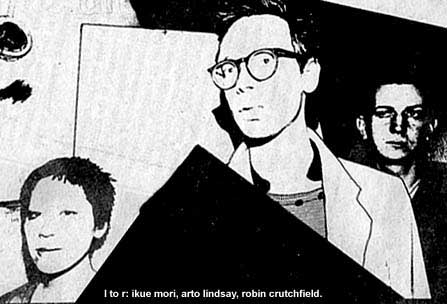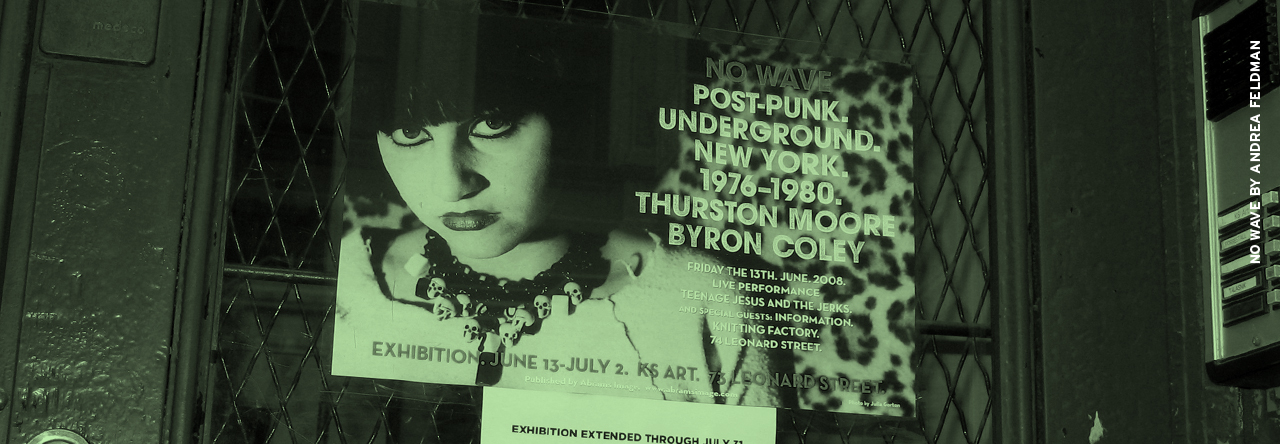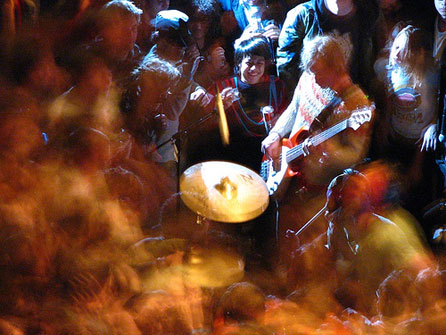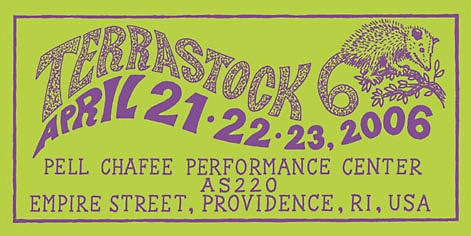
Oh, the seventies. Remember how long it took to shake off the lumbering metallic bombast, the long shadow of overkill and excess?
Not that long, it turns out, if you were recombinant power-trio DNA —who threw off the mutant overlord Tolkien-esque beast of burden and helped make the world safe for music that sliced and feinted and struck nerves as well as chords. Short/sharp/shock songs that drew blood. And even at their weakest —when they flailed wildly instead of attacking— they spoke in tongues & made abrasiveness new —although they were by no means the first to do so. See also: various flavors of downtown Mutant Disco, first wave, second wave, British wave… Even today, though, their music rings with a particularly high-pitched frisson of sexual tension & dread that’s been echoed but rarely equaled.
RL Crutchfield played keyboards in the first iteration of DNA, helping to anchor Arto Lindsay’s wild abandonment. He went on to form his own group, Dark Day, which at various points in its very fluid lineup also included Nina Canal (Ut), Phil Kline (the Del-Byzanteens), Stephen Brown (Tuxedomoon), and Nancy Arlen (Mars). The first Dark Day album, Exterminating Angel, was issued on Charles Ball’s ill-fated Lust/Unlust label (which also put out the first Ut cassette).
Crutchfield was kind enough to answer some questions for inclusion in my recent No Wave piece . I’m posting his answers in full here, as I think he’s got a concisely eloquent take on the time period that is well worth sharing.
There’s been a marked resurgence of interest in No Wave recently, due in part to a series of high-profile reissues (No New York being the most long-awaited). The sound seems to be everywhere, thanks to groups like !!!, Liars, Glass Candy, Les Georges Leningrad, Erase Errata, etc. Why do you think it might be newly relevant? Or is this just a case of plundering the past for anything that can be co-opted?
I’m quite surprised myself over the interest in that period now. There’s that old saying one man’s trash is another man’s treasure. Everything has its own context, its time, its place. Things that sounded like crap to me then sound great now. Stuff I loved then sounds like crap now. Music is subjective, it changes and tastes change. Some days I listen to DNA and think, man, what garbage this was; then other days I listen and think, “Wow, that was pretty incredible!” and have to laugh to myself.
Recently the No New York album finally came out on an affordable CD; there’s a collection called DNA on DNA; a Theoretical Girls disc; a Mars collection; Lydia Lunch has been releasing her own stuff for years; several NYNoise and ZE Records compilations have come out in the last couple of years. A Delta 5 disc just came out. A lot of stuff from the late ’70s and early 80s is resurfacing.
I recall that time as one where the scene burst wide open to experimentation, from art into music. It was the beginning of the do-it-yourself era with bands, labels, and venues breaking out of old molds and trying new things.
The most wonderful thing about it to me, was to spread the word that, hey, you don’t need musical training, or even much talent, if you’ve the will, you’ll find the way. Any kid at home with a craving to do it, can do it. Music for the everyman. Rock music when it comes down to it, isn’t about skill, it’s about the need for self-expression. To release all the pent-up stuff teens are holding in and let it out. Let it explode with energy.
There’s currently an eye-opening new show at New York University’s Grey Gallery and Fales Library open here called The Downtown Art Show: 1974-84. It was a decade documented to great lengths in all its aberrations. It covers performance art to music to underground film and so on. It gives a pretty good overview of some of what was bubbling at the surface of those times.
As to all the labels that are re-issuing that old stuff, you’d have to ask them what made them do it now. They must feel there’s a current market for it. It gives one a sense of the beginnings and history behind the whole indie movement. And living it, it makes you wonder, wow, where did all the time go so fast. That was over a quarter of a century ago!
At the time, was there a sense of this being a movement of sorts, a marked break from what had come before? Or was it a lot more organic than that? I have this possibly naïve notion that everyone in DNA, Theoretical Girls, Mars, Ut, etc. all lived in the same four-block radius, shared rehearsal spaces and talked art & music together, leading to this marvelous sort-of cross-pollination of musical styles and influences happening all at once. What was it really like?
Some of it was that. The scene started smaller, poor downtown artists and kids hanging out at art gallery openings for the free wine, and sharing ideas at cheap Tribeca Bars. A lot of the collaboration came through attending a variety of small events like performance art and private loft concerts and so on. Hanging out, meeting, talking into the night about ideas. Pooling money to timeshare rehearsal spaces. When you didn’t have a job, or a TV, and only had a cheap crash pad on the lower east side with low rent, there wasn’t much to occupy your time but make art, talk about art, and experience other people’s art. As bands we even pooled our efforts to make our way into bookings at places like CBGB’s where the music was a little too different from The Ramones or Patti Smith to interest Hilly Krystal into booking us. We peppered the audience at early gigs with our own raucously cheering supporters leaving Hilly to think that this actually had appeal to more than a few. >>
The bands that emerged from the East Village in the late 70s/early 80s are so variegated that it’s hard to pinpoint a New York “sound” per se. The definition of what, precisely, constitutes “No Wave” is somewhat in the eye of the beholder, thanks to the music’s genre-fluidity. What would be your personal definition of the term “No Wave”?
Well, Lydia Lunch of Teenage Jesus & The Jerks coined the phrase in an interview in The New York Rocker with Roy Trakin, when he asked her of her music was new wave. She leered and jeered at him like he was an idiot, with the crack “’New Wave’?…more like No Wave!!!” You’d have to talk to her, but her band and a few others really reacted against the whole 3-chord rock school of bands that were coming out of England like the Sex Pistols. It was a kind of disassembling of what passed for the time as rock and roll, taking apart the chords, the rhythms, the over-rehearsed quality of it. It needed to be screamingly raw and fresh like a newborn baby, screaming its lungs out, pulled into a polyester 70s world of American tedium.
For me, that experimentation was the No Wave, it was a wave that didn’t ride in on a wave. The sound wave was jarring, uncomfortable. It didn’t soothe the soul or lull one into a sense of security. It may have taken elements from other musics, but torqued them in a way that bore little resemblance to the original. There were elements of blues, rock, jazz, funk, etc. But they were toyed with, twisted, wrenched and fabricated into something crudely different that appealed to people on a cerebral level and challenged opinions on what was and wasn’t music; something like John Cage had done to a more scholarly audience. A lot of band members didn’t even find satisfying solutions for their ideas in one band; they had several going at one time, or guested in other bands, or helped with new film soundtracks, installations, etc. It was a very collaborative time.

What were reactions to early DNA and Dark Day shows like? Was there less of a strict boundary between performer and audience then? (At least in small, NYC clubs)?
The audiences started out being other bands and artists who were very supportive. You had a few old school rock fans cursing and throwing bottles, but mostly they were made to feel like they weren’t cool; like they were somehow out of the loop; their jeers being drowned out by supporters cheers and screams. It put a whole mind-f**k on what it was to be cool; the foundations of people who thought they were cool, were pulled right out from under them. Lydia could tell you a lot about that. She was the master of that kind of mind-f**k. She punished her audiences with brilliantly brutal music; no two hour sets with 20 minute guitar solos, Teenage Jesus & The Jerks delivered 8 minute sets of one minute songs, in a one-two punch onslaught that had them begging for more. She was an artistic underage genius! She minimalized the structure of her music, abbreviated it, and punctuated it. She took away her drummer’s drums and left him with only a snare and one cymbal to play. I think at one point she even made him use only one drumstick. The basslines were simple and insistent. Her guitar stopped and started in spasmodic jerks the way a sob grabs at you. I really think Teenage Jesus & The Jerks as a conception was the most amazing thing that came out of music in the entire decade of the ’70s.
Does the same spirit still exist in post-Giuliani, post-9/11, post-CB’s New York? As a longtime resident and musician in NYC, have you seen the center of creativity slowly shift? Or is NYC as vital as ever?
I couldn’t tell you. When we started out, we were a small handful of bands and clubs and independent labels; then the eighties hit and next generations of bands and labels and clubs multiplied until it seemed to get out of control and one got lost in the crowd. The odd man out is always interesting and refreshing until the odd becomes the norm; then you start craving muzak or something that rebels against the rebels.
What do you do when you’re not making music? And, if you didn’t have music as an outlet, what do you think you’d do instead?
I’ve gotten way too complacent as I’ve gotten older. And I know that’s not good for creativity. They say it takes a bit of grit to discomfort an oyster into creating a pearl. There’s something to that. When you’ve got little in your life to make you comfortable, you get creative. I tend to retreat from things that discomfort me. I keep updating my several websites. I write stories. I research. I experiment with new instruments; old ones actually; I’ve given up electronics after a few years of working with them in favor of ancient acoustic instruments, African drums, harps, and lyres. They have a spirituality in them that connects me with the past, the prehistoric past. One doesn’t always have music, so one writes, one paints; it’s about trying to find joy in the colors, and smells, and sounds, and taste of living.
***
The 32-track collection DNA on DNA is available from Twisted Village. For more on Crutchfield’s post-DNA work, look no further than his site, which includes extensives histories and discographies for both DNA & Dark Day. His review of No New York is here.
20JazzFunkGreats beat us to “No, Nothing, Never” so I’m posting “Arp’s Carpet” and one of Robin’s DNA songs, “Not Moving.” Thanks to the wonders of modern technology, you can even watch the video for Arp’s Carpet via YouTube.
 DNA, “Not Moving”
DNA, “Not Moving”
 Dark Day, “Arp’s Carpet”
Dark Day, “Arp’s Carpet”
![]() Kemialliset Ystävät, “Paha” [from the T6 Compilation]
Kemialliset Ystävät, “Paha” [from the T6 Compilation]![]() Spires That In The Sunset Rise, “Imaginary Skin” [Available from Secret Eye]
Spires That In The Sunset Rise, “Imaginary Skin” [Available from Secret Eye]




